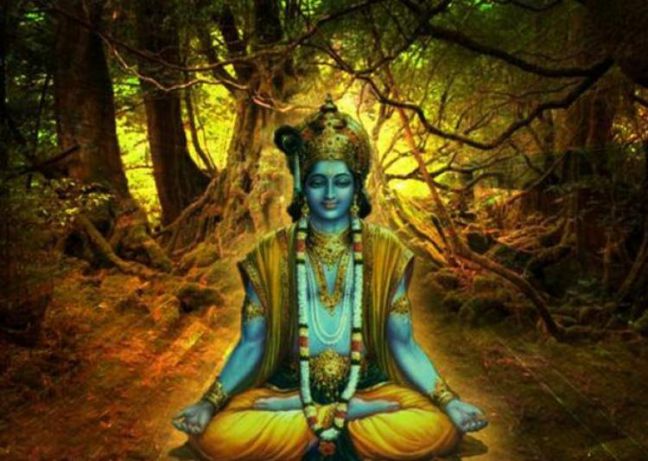No products in the cart.
Bhakti or devotion holds a very unique and important place on the path to God. It’s very common that all the yoga traditions are described as spokes of a wheel that all lead to the same hub (spiritual enlightenment).
The 4 Yoga Traditions
Generally, four yoga traditions are described (with the remainder falling into subgroups of these), and the type of temperament that is attracted to that tradition:
1 Jnana Yoga ( Gyan) – philosophical and intellectual temperament
2.Bhakti Yoga – emotional temperment
3.Raja Yoga – mystical and scientific temperament
4.Karma Yoga – active temperament
What is Bhakti Yoga?
Bhakti Yoga is one of the four main yogic paths to enlightenment. Bhakti means “devotion” or “love” and this path contains various practices to unite the bhakta (Bhakti Yoga practitioner) with the Divine.Bhakti Yoga is considered the easiest yogic path to master and the most direct method to experience the unity of mind, body and spirit. While Hatha Yoga requires a strong and flexible body, Raja Yoga requires a disciplined and concentrated mind, and Jnana Yoga requires a keen intellect, the only requirement for Bhakti Yoga is an open, loving heart. But Bhakti Yoga complements other paths of yoga well, and it is said that jnana (knowledge or wisdom) will dawn by itself when you engage in the devotional practices of Bhakti Yoga.
Bhakti Yoga is pure spiritual devotion, of love for God which is Love. The Deity is the beloved and the devotee is the lover. In Bhakti yoga, everything is but a manifestation of the divine and all else is meaningless, including the Ego. When the Bhakta is blessed by divine grace he feels an undivided union and non-dual consciousness prevails. Bhakti Yoga is regarded as the most direct method to merge in cosmic consciousness.
Bhakti yoga is based on the doctrine “Love is God and God is Love”. The bhakta experiences separation and longs to meet or even just glimpse his beloved. Nothing else attracts him, nothing else holds his attention, all else is meaningless.
The 9 Practices of Bhakti Yoga
There are nine main practices of Bhakti Yoga that can be practiced independently or together. Each of these limbs creates a specific bhava (feeling) that appeals to different inner constitutions of practitioners.
The Nine Limbs of Devotion
1. Shravana – “listening” to the ancient scriptures, especially potent if told by a saint or genuine bhakta.
2. Kirtana – “singing” devotional songs, usually practiced in a call-and-response group format.
3. Smarana – “remembering” the Divine by constantly meditating upon its name and form.
4. Padasevana – “service at the feet” of the Divine, which incorporates the practice of karma yoga (selfless service) with bhakti (devotion).
5. Archana – the “ritual worship” of the Divine through practices such as puja (deity worship), and havan or homa (fire offering).
6. Vandana – the “prostration” before the image of one’s chosen image or representation of the Divine.
7. Dasya – the “unquestioning” devotion of the Divine involving the cultivation of serving the will of God instead of one’s own ego.
8. Sakhya – the “friendship” and relationship established between the Divine and the devotee.
9. Atmanivedana – the “self-offering” and complete surrender of the self to the Divine.
The origins of Bhakti can be seen in the upanishads, specifically the Shvetashvatara Upanishad. The Bhagavad Gita, and the Puranas are important scriptures that expound the philosophy of bhakti yoga. Hindu movements in which bhakti yoga is the main practice are called bhakti movements – the major schools of which are Vaishnavism, Shaivism, and Shaktism.
The Bhagavad Gita is a cornerstone of Hindu bhakti theism, especially among Vaishnavists. The Bhagavad Gita stresses that love and innocent pure intentions are the most powerful motive forces in a devotee’s spiritual life.
“Engage your mind always in thinking of Me, become My devotee, offer obeisances to Me and worship Me. Being completely absorbed in Me, surely you will come to Me.” (Bhagavath-Gita 9.34)
“One can understand Me as I am, as the Supreme Personality of Godhead, only by devotional service. And when one is in full consciousness of Me by such devotion, he can enter into the kingdom of God.” (Bhagavath-Gita 18.55)
Benefits of Bhakti Yoga

The benefits of Bhakti Yoga are immense, as Swami Sivananda writes, “Bhakti softens the heart and removes jealousy, hatred, lust, anger, egoism, pride and arrogance. It infuses joy, divine ecstasy, bliss, peace and knowledge. All cares, worries and anxieties, fears, mental torments and tribulations entirely vanish. The devotee is freed from the Samsaric wheel of births and deaths. He attains the immortal abode of everlasting peace, bliss and knowledge”.
The ultimate goal in the practice of Bhakti yoga is to reach the state of rasa (essence), a feeling of pure bliss achieved in the devotional surrender to the Divine.
According to the Bhagavad gita, single minded devotion to Vasudeva is the surest path to self-realization. In whatever way a devotee approaches Him, He accepts them, for men approach Him from all directions (4.11). Such souls are rare but dearer to God who have completely surrendered themselves to Him and spend their lives in total devotion to and continuous contemplation of Him.
The mahatmas (great souls) know how to worship God with undivided mind, as they know Him to be Imperishable and the true cause of all beings (9.13). Always singing His glories, striving to attain Him, with firm determination, prostrating themselves before Him, ever established in Him, they worship Him (9.14).
A true devotee is never lost to God. He lives in His constant gaze and under His continuous protection. The Lord always takes care of the needs of a pure devotee who is totally lost in pure devotion to him (9.22). Pure devotion is the highest form of love to which God responds with unconditional love and immediate attention.
Those who worship Vasudeva Krishna with single minded devotion are speedily rescued from the ocean of mortal existence.(12.7). A man should live in God, with his mind and intelligence fixed in Him, to attain Him (12.8). If devotion with concentration of mind is not possible, then one should practice concentration (12.9). If that is also not possible then one should take refuge in Him and renounce all fruits of actions (12.11).
Bhakti yoga teaches that the final end of all religions can be reached through love and worship of the personal God, who is the Creator and Governor of the phenomenal universe. It leads to the same destination as all the other branches of Yoga, but is especially suited for such as are emotional in their nature and have the feeling of love and devotion highly developed. It is for those devotees who, conscious of their own weakness arising from lack of self-control and of knowledge, seek help from outside; and who, taking refuge in the Supreme, pray to Him for forgiveness and for pardon of sins committed through ignorance of the moral and spiritual laws that govern our lives.
Bhakti Yoga has two grades,–the first is called “Gauni,” or preparatory and includes all the preliminary practices; the second is “Para,” or the state of supreme love and devotion to God. A beginner in Bhakti Yoga should first of all prepare the ground of his heart by freeing it from attachment to earthly objects and sense-pleasures; then by arousing in it extreme longing to see God, to realize Divinity, to go to the Source of all knowledge, and to reach perfection and God-consciousness in this life. He must be absolutely earnest and sincere. He should seek the company of a true lover of God, whose life is pure and spotless, who has renounced all worldly connections, and who has realized the true relation which the individual soul bears to the Universal Spirit. If, by good fortune, he meets such a real Bhakta, he should receive from him the seed of Bhakti, plant it in the ground of his heart, and by faithfully following the instructions of the master, take special care to keep it alive and make it grow, until it becomes a large tree bearing the fruit of Divine Love. He should have respect, reverence, and love for his master, who will open his spiritual eye and transmit his own spiritual powers to his soul. When these powers begin to work, the soul will be awakened from the deep sleep of ignorance and self-delusion.

The Guru, or spiritual eye-opener, knowing the natural tendency of the disciple, will advise him to look upon God as his Master, or as his Father or Mother, and will thus establish a definite relation between his soul and God. Henceforth the disciple should learn to worship or pray to the Supreme through this particular relation. At this stage symbols, rituals, ceremonies may appeal to his mind; or he may repeat some name of the Lord that signifies the special aspect of the Divinity corresponding to the relation which he bears to Him. Constant repetition of such a name will help the mind of the neophyte to become concentrated upon the Divine Being. During this period he should avoid such company, such places, and such amusements as make him forget his chosen Ideal. He should live a chaste and pure life, always discriminating right from wrong and struggling to control his passions and desires by directing them Godward. He should be angry with himself for not realizing his ideal; he should hate his sinful nature because it keeps him away from the path of Bhakti and prevents him from remembering his Beloved. Thus he will gradually succeed in correcting his faults and in gaining control over his animal nature.
A traveller on the path of Bhakti should observe cleanliness of body and mind, should be truthful, and lead a simple life, without injuring any living creature mentally or physically. He should not kill any animal for his food, neither should he covet that which does not belong to him. He should, furthermore, obey the laws of health which tend to make him physically strong, as well as those moral laws the violation of which weakens the mind.
So long as the devotee thinks of God with a form and believes that He is outside of his soul and of the universe, he can make a mental picture of Him and worship the Divine Ideal through that form; or he may keep before him some symbolic figure like the cross which will remind him of his Ideal at the time of devotion. But a Bhakta should never mistake the imaginary form or the symbolic figure for the real Ideal. Wherever there is such a mistake there is to be found spiritual degeneration and the expression of ignorance in the form of sectarianism, bigotry, fanaticism.
Gradually, as the Bhakta approaches God, he will rise above such dualistic conceptions and realize that his Beloved is not only transcendent but immanent in nature, that nature is His body, that He dwells everywhere, that He is the Soul of our souls and the Life of our life, that He is the one stupendous Whole while we are His parts.
The Bhakta then reaches that state which is called qualified non-dualism. He sees that from the minutest insect up to man all living creatures are related to the Iswara is a part is related to the whole. Therefore he cannot kill or injure any living being. Understanding that everything pertaining to any part belongs in reality to the whole, he says, “Whatever is mine is Thine”; and it is from this moment that absolute self-resignation and self-surrender to the will of the Iswara begin to reign supreme in the soul of the Yogi. Then he is able to say from the bottom of his heart, “Let Thy will be done,” and never again can he forget that his soul is a part of the Iswara. His devotion henceforth consists in remembering this new relation, and his worship takes a new form. Whatever he does with mind or body becomes an act of worship of the Supreme Whole, for he realizes that he possesses no power that does not belong to God. Eating, drinking, walking, talking, and every other work of his daily life become acts of devotion, and the entire existence of such a Bhakta is a continuous series of acts of worship. Then the heart is purified and selfishness is dead.
The devotee thus rises to the second grade of Bhakti Yoga and begins to taste that Divine Love which is the fruit of the tree of Bhakti. Here all distinction between lover and Beloved disappears; the lover, the Beloved and Love all merge into one ocean of Divinity. The soul of the Bhakta is transformed, and manifesting omniscience, God-consciousness, perfect freedom, and all other Divine qualities, it attains to the highest ideal of Bhakti Yoga.






